Madonnas and Miracles: The Holy Home in Renaissance Italy, Fitzwilliam Museum, Cambridge | reviews, news & interviews
Madonnas and Miracles: The Holy Home in Renaissance Italy, Fitzwilliam Museum, Cambridge
Madonnas and Miracles: The Holy Home in Renaissance Italy, Fitzwilliam Museum, Cambridge
Lovely, scholarly, multi-sensory insight into domestic Italy 500 years ago
A lovely, scholarly and gently revelatory exhibition, Madonnas and Miracles explores a neglected area of the perennially popular and much-studied Italian Renaissance – the place of piety in the Renaissance home. We are used to admiring the great 15th- and 16th-century gilded altarpieces and religious frescoes of Italian churches, palace chapels and convents, but this exhibition – one of the main outcomes of a generous four- year European funded research project – shows how the laity experienced religion in the context of their everyday domestic lives, as well as during extraordinary occurrences, such as the experience of divine miracles within the intimacy of their own four walls.
So we have a fascinating array of higher-end religious images (painting, drawing and sculpture) created to facilitate domestic devotion (some by notable artists), alongside household objects such as cutlery, furniture, textiles, ceramics, votive panels, books, rosaries and jewellery, and even tiny, screwed-up pieces of paper containing images and prayers. Pedlars and merchants (taking advantage of early methods of mass production, such as printing) produced and sold a wide range of affordable products alongside the more elite works. These may be cheaper and simpler, such as an endearingly clumsy early painted statuette of the nursing Virgin – but they were nonetheless as deeply treasured as some of the more luxurious objects (for example, an exquisite carved ivory Comb with the Annunciation, c.1450–1500, pictured below, Kunstgewerbemuseum, Berlin). The show – which has deep tentacles into the University of Cambridge – looks at how richly religious imagery and home life interacted with each other, framing activities from getting up, eating, going about one’s business, avoiding everyday perils (e.g. rabid dogs) and going to bed, to landmark occasions such as marriage, birth and death (a home birth or a "good" death was, of course, an intensely spiritual experience). It also shows how ideals of domesticity helped shape ideas of spirituality, resulting in "homely" religious images that adults and children could readily identify with. The Master of the Osservanza’s small luminous painted triptych of the Birth of the Virgin, a suitable object for female devotion, shows us Mary’s aged mother Anna, propped up in a bed with a glorious golden counterpane (in a prosperous domestic interior) shortly after miraculously giving birth.
The show – which has deep tentacles into the University of Cambridge – looks at how richly religious imagery and home life interacted with each other, framing activities from getting up, eating, going about one’s business, avoiding everyday perils (e.g. rabid dogs) and going to bed, to landmark occasions such as marriage, birth and death (a home birth or a "good" death was, of course, an intensely spiritual experience). It also shows how ideals of domesticity helped shape ideas of spirituality, resulting in "homely" religious images that adults and children could readily identify with. The Master of the Osservanza’s small luminous painted triptych of the Birth of the Virgin, a suitable object for female devotion, shows us Mary’s aged mother Anna, propped up in a bed with a glorious golden counterpane (in a prosperous domestic interior) shortly after miraculously giving birth.
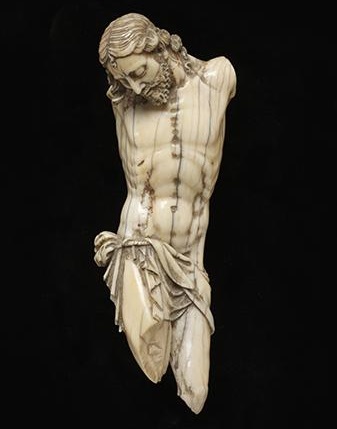 The Fitzwilliam’s galleries have been broken up into small, richly coloured (forest green), Renaissance rooms with low-level lighting, so that the colours and materials of the paintings and objects really glow – to encourage prolonged looking. It works beautifully. Giovanni Antonio Gualterio’s ivory of Christ’s Corpus for a Crucifix , c.1599 (pictured)– which would be easily overlooked in its London "home" (amongst the treasures of the V&A in London) – is one of the highlights of the show. It succeeds (as it would as a treasured object in a private context) in inviting identification with Christ’s humanity and suffering and is intended, no doubt, to inspire love mingled with pain and acceptance.
The Fitzwilliam’s galleries have been broken up into small, richly coloured (forest green), Renaissance rooms with low-level lighting, so that the colours and materials of the paintings and objects really glow – to encourage prolonged looking. It works beautifully. Giovanni Antonio Gualterio’s ivory of Christ’s Corpus for a Crucifix , c.1599 (pictured)– which would be easily overlooked in its London "home" (amongst the treasures of the V&A in London) – is one of the highlights of the show. It succeeds (as it would as a treasured object in a private context) in inviting identification with Christ’s humanity and suffering and is intended, no doubt, to inspire love mingled with pain and acceptance.
Another highlight of the show is a large domestic "tondo" (round) panel painting from the studio of Botticelli, fresh from its recent conservation, with the dull varnish removed and the original vibrancy revealed. It is a refined, decorative and tender work, rendered affordable (for home consumption) by the fact that it is a studio production, lacking the emotional and compositional complexity of a work by Botticelli’s own hand, and devoid of the elaborate gold embellishment that a wealthy patron would have demanded.
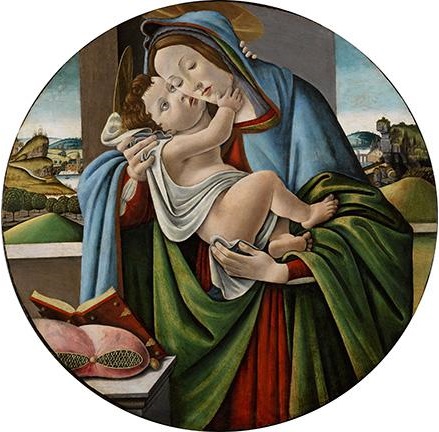 A more archaic Madonna and Child by Pietro de Niccolo da Orvieto (first half of 15th century) – with its painted marble back – also revealed by recent cleaning shows how such an image (part Byzantine icon/part Renaissance naturalism/part dream-like abstraction) would have been handled as an object, with the Virgin’s intense and benign gaze designed to meet the reverent gaze of the viewer, while the Christ child’s hand delicately touching his mother’s neck invites touching back. (Pictured above left: Studio of Sandro Botticelli, Virgin and Child, c.1480–90 © The Fitzwilliam Museum, University of Cambridge)
A more archaic Madonna and Child by Pietro de Niccolo da Orvieto (first half of 15th century) – with its painted marble back – also revealed by recent cleaning shows how such an image (part Byzantine icon/part Renaissance naturalism/part dream-like abstraction) would have been handled as an object, with the Virgin’s intense and benign gaze designed to meet the reverent gaze of the viewer, while the Christ child’s hand delicately touching his mother’s neck invites touching back. (Pictured above left: Studio of Sandro Botticelli, Virgin and Child, c.1480–90 © The Fitzwilliam Museum, University of Cambridge)
A rare drawing by Fra Angelico of The Dead Christ (c.1432-4) has areas which are marked and abraded, possibly through the act of kissing and touching (the points of contact, as the catalogue explains, "seem to correspond with the places where Mary Magdalene and John the Evangelist touch and kiss Christ’s body in the Descent from the Cross altarpiece" (the figure is repeated from Fra Angelico’s masterpiece in the Museo di San Marco in Florence).
Among the more surprising objects are four 16th-century ebony or ivory-handled knives, each engraved with one of four voice parts and their associated music notation (see gallery of images overleaf). The effect, as the four voices sung the Benediction and Grace at the meal in a high-end home, can be experienced on the adjacent sound station (this is a well-designed multi-sensory exhibition). Another object, the humblest in the exhibition, is a tiny piece of paper, which would have probably been purchased cheaply in the piazza, containing three prayers (two on one side to protect against fever and thunderstorms, one on the other to protect against lost items). This early form of insurance – inhabiting a grey area between devotion, magic and superstition – would have been worn in a pouch close to the body.
At the end of the exhibition, we have the treat of being able to see 27 votive tablets, temporarily removed from the cluttered walls of three different church shrines in Italy, which have never been loaned before and are from three lesser-known regions (Naples, the Marche and the Venetian terrafirma). These cheap-as-chips panels, painted in tempera, give thanks for miracles received, with their imagery reflecting the response to prayers in moments of crisis (when the Virgin or Saints intervene on a family’s behalf). One – from the same area that has recently been ravaged by earthquakes – poignantly shows buildings collapsing from earthquake tremors around a family praying fervently in a domestic interior (who survived to commission the plaque). Here, thanks to this jewel of a show, we truly have history and a history of art told by ordinary people, rather than by wealthy rulers and learned institutions.
- Madonnas and Miracles: The Holy Home in Renaissance Italy at the Fitzwilliam Museum, Cambridge until 4 June
- More visual art reviews on theartsdesk
rating
Share this article
The future of Arts Journalism
You can stop theartsdesk.com closing!
We urgently need financing to survive. Our fundraising drive has thus far raised £33,000 but we need to reach £100,000 or we will be forced to close. Please contribute here: https://gofund.me/c3f6033d
And if you can forward this information to anyone who might assist, we’d be grateful.

Subscribe to theartsdesk.com
Thank you for continuing to read our work on theartsdesk.com. For unlimited access to every article in its entirety, including our archive of more than 15,000 pieces, we're asking for £5 per month or £40 per year. We feel it's a very good deal, and hope you do too.
To take a subscription now simply click here.
And if you're looking for that extra gift for a friend or family member, why not treat them to a theartsdesk.com gift subscription?
more Visual arts
 Help to give theartsdesk a future!
Support our GoFundMe appeal
Help to give theartsdesk a future!
Support our GoFundMe appeal
 Echoes: Stone Circles, Community and Heritage, Stonehenge Visitor Centre review - young photographers explore ancient resonances
The ancient monument opens its first exhibition of new photography
Echoes: Stone Circles, Community and Heritage, Stonehenge Visitor Centre review - young photographers explore ancient resonances
The ancient monument opens its first exhibition of new photography
 Hylozoic/Desires: Salt Cosmologies, Somerset House and The Hedge of Halomancy, Tate Britain review - the power of white powder
A strong message diluted by space and time
Hylozoic/Desires: Salt Cosmologies, Somerset House and The Hedge of Halomancy, Tate Britain review - the power of white powder
A strong message diluted by space and time
 Mickalene Thomas, All About Love, Hayward Gallery review - all that glitters
The shock of the glue: rhinestones to the ready
Mickalene Thomas, All About Love, Hayward Gallery review - all that glitters
The shock of the glue: rhinestones to the ready
 Interview: Polar photographer Sebastian Copeland talks about the dramatic changes in the Arctic
An ominous shift has come with dark patches appearing on the Greenland ice sheet
Interview: Polar photographer Sebastian Copeland talks about the dramatic changes in the Arctic
An ominous shift has come with dark patches appearing on the Greenland ice sheet
 Donald Rodney: Visceral Canker, Whitechapel Gallery review - absence made powerfully present
Illness as a drive to creativity
Donald Rodney: Visceral Canker, Whitechapel Gallery review - absence made powerfully present
Illness as a drive to creativity
 Noah Davis, Barbican review - the ordinary made strangely compelling
A voice from the margins
Noah Davis, Barbican review - the ordinary made strangely compelling
A voice from the margins
 Best of 2024: Visual Arts
A great year for women artists
Best of 2024: Visual Arts
A great year for women artists
 Electric Dreams: Art and Technology Before the Internet, Tate Modern review - an exhaustive and exhausting show
Flashing lights, beeps and buzzes are diverting, but quickly pall
Electric Dreams: Art and Technology Before the Internet, Tate Modern review - an exhaustive and exhausting show
Flashing lights, beeps and buzzes are diverting, but quickly pall
 ARK: United States V by Laurie Anderson, Aviva Studios, Manchester review - a vessel for the thoughts and imaginings of a lifetime
Despite anticipating disaster, this mesmerising voyage is full of hope
ARK: United States V by Laurie Anderson, Aviva Studios, Manchester review - a vessel for the thoughts and imaginings of a lifetime
Despite anticipating disaster, this mesmerising voyage is full of hope
 Lygia Clark: The I and the You, Sonia Boyce: An Awkward Relation, Whitechapel Gallery review - breaking boundaries
Two artists, 50 years apart, invite audience participation
Lygia Clark: The I and the You, Sonia Boyce: An Awkward Relation, Whitechapel Gallery review - breaking boundaries
Two artists, 50 years apart, invite audience participation



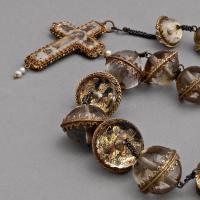
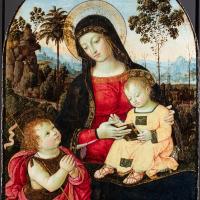
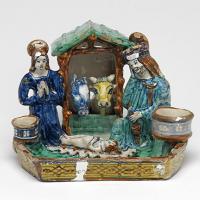

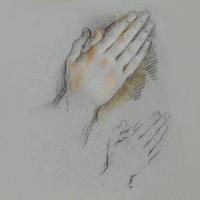
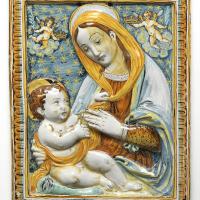
Add comment